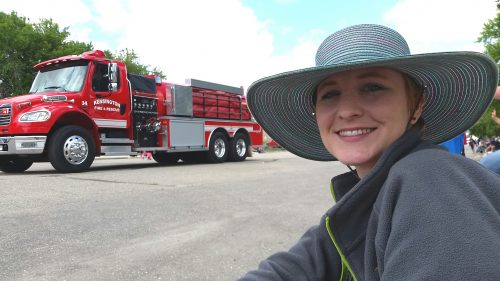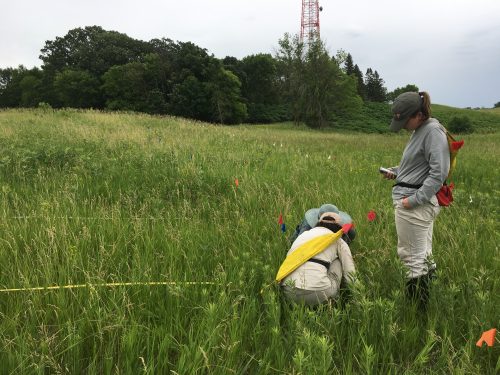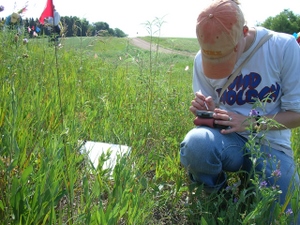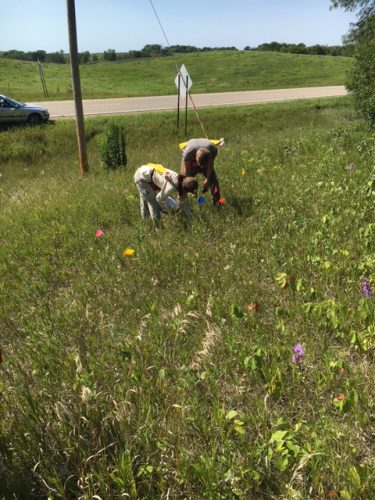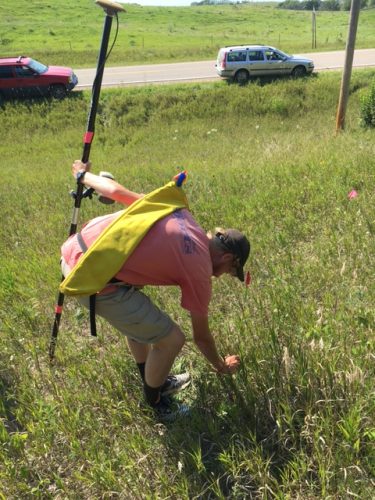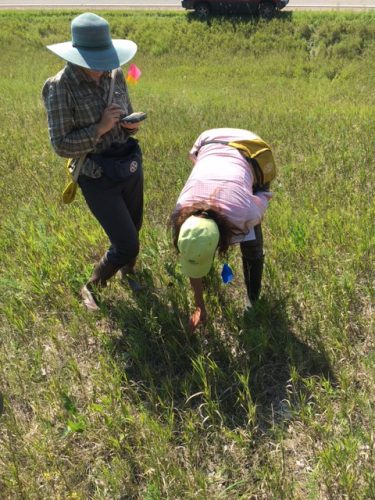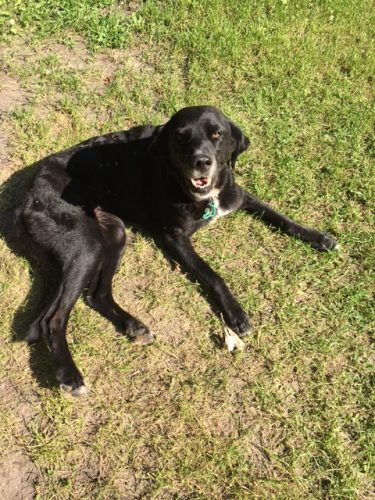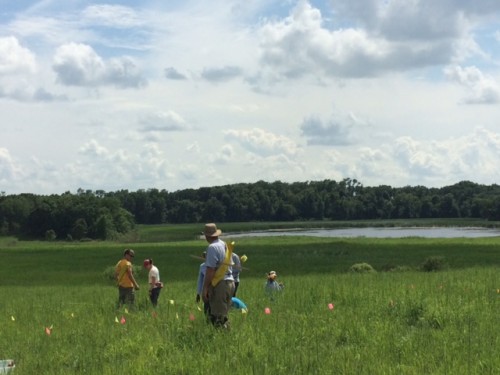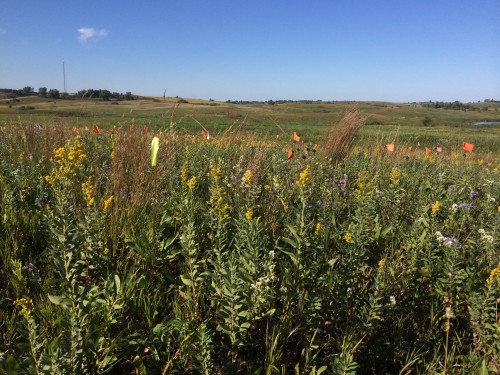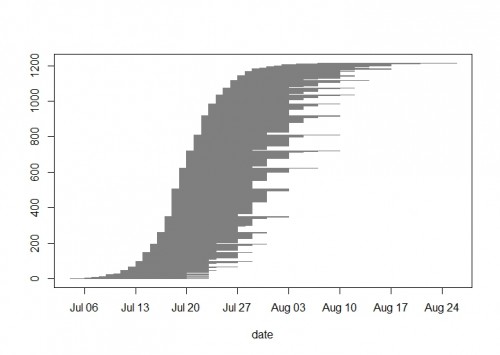|
|
Like Wes said yesterday, it’s pretty clear the crew living at the Andes ski condo enjoys quiet and relaxing mornings. After I made myself waffles and enjoyed a tall cup of hazelnut coffee, Lea and I ventured out to Alexandria to run errands. We stopped by the trusty laundromat to wash our clothes, some of which had wild parsnip oil on it. While our clothes were in the wash, we went grocery shopping for the week. I’m making pasta salad on Wednesday, and I had fun searching the store for all the ingredients I needed. When we checked-out of the store, we returned to our trusty laundromat and switched our clothes to the dryer. To utilize our time, we stepped next door to the coffee shop. There, Lea thought through some of her research questions, and I worked on my experimental design for my summer REU project.
 Lea working in the coffee shop When we collected our laundry, we came back to Andes, and we all enjoyed the braut dinner Wes made. After dinner, we all drank tall glasses of chocolate milk. Yum. 🙂
Team Echinacea spent our Sunday morning relaxing around Andes Tower Hills. Over breakfast and coffee, we decided on a time to leave for the Runestone Days lunch buffet and parade. A bit later, I walked around the Andes property to investigate the nearby lake and enjoy the late morning’s cool breeze. Even though I’ve been in Minnesota for nearly a week, I am still refreshed by the temperate climate and the vast stretches of prairie-covered hills in this area.
By the time I walked back to our cabin, the rest of the team was ready to head over to Kensington to feast at the Father’s Day buffet. Wes gathered his tuba, we all gathered our appetite, and soon enough, we were enjoying delicious fish, carrots, potatoes, and pudding. Yum! Around 1:00, Wes headed out to meet up with the Morris County Band, so they could rehearse before floating in the parade. The other four of us enjoyed the beautiful weather as we watched. We collected candy and ice cream treats distributed by parade participants, and we cheered for the Morris County Band when their float passed. What a fun afternoon!
Now, Leah is setting up her drone, others are relaxing, and I have plans to continue research on my REU project. I’ve enjoyed my relaxing weekend, but I’m ready to continue work in the prairies tomorrow!
Ashley
 Leah watching the Runestone Days parade.
Today was the third day in the field for Team Echinacea 2017. We all started out in P1, where we split up and did various tasks. Alex and Ashley took on the riskiest task and weeded some invasive bird’s foot trefoil around the plot that was among some poison ivy. Will, Lea, Wes, and I got the 10-meter signs and flag markers up and organized. Stuart and Anna started taking on the invasive hawkweed that has been getting into the plot and spreading, and eventually all of us were wrestling with it. The hawkweed has some incredible rhizomes that spread around to nets and nets of rosettes. Will and I found an estimated 45% hawkweed cover in one part of the plot. Here are some of the comments you might have heard from all of us while trying to get these out of the ground:
“Anytime you think you’ve found them all, you haven’t.”
“You will be champion of the longest rhizome!”
“I think I am becoming allergic to hawkweed.”
Weeding was fun, but I think we were all ready for lunch when it came around. At lunch we talked about doing a yellow pan trap experiment this year to catch and identify bees and see how their abundance and diversity relates to surrounding vegetation. Lea also gave an intro to her experiment for the summer, and we talked about potential REU projects.
After lunch we headed over to P8 and started learning how to collect data on the Echinacea growing there. Returners helped the newcomers start to get a hang of navigating the plot site, collecting data on visors, and finding and measuring Echinacea. We finished the day with a watermelon on the porch.
It was a great week. I’m excited for more.
Tracie
 Lea, Gretel, and Ashley in P8.
An ideal position for either an undergraduate or a graduate interested in gaining field experience.
The Echinacea Project is looking for interested and enthusiastic summer field assistants for the 2017 summer field season. Our project investigates how small population size and reduced genetic diversity influence individual fitness, population demographics, plant-insect interactions and evolution in the purple coneflower, Echinacea angustifolia. Summer field assistants will help maintain experimental plots, observe pollinators, remove invasive species, harvest seed, collect data for several long-term research projects, and establish new experiments. This is a great opportunity for aspiring ecologists, conservation biologists, and evolutionary biologists to gain research experience and learn about the ecology and evolution of plants in fragmented prairies! Read about what it’s like working and living in Minnesota.
Qualifications: We are looking for undergraduates or recent graduates who are willing to work outdoors in adverse conditions, exhibit patience, possess good hand-eye coordination and fine motor skills, work well independently and as part of a team, and have an interest in scientific research. No experience is necessary, but you must be enthusiastic and hard-working.
Details: The field season runs from June to October. We anticipate hiring assistants from June through August, with the possibility of extension later into the fall. There is a $500/week stipend and housing is supplied.
How to apply
- Please fill out the online form at this link.
- Send a cover letter, your resume, and a transcript (unofficial OK) in one email to echinaceaProject@gmail.com. Use the subject line: “Summer Field Assistant 2017” and format your cover letter, resume, and transcript as pdf files. Begin each file name with your surname. Please ask one of your references to send a letter of recommendation to echinaceaProject@gmail.com.
 Laura taking data In your cover letter please include…
- why you are interested
- what are your future plans
- when you can start and end
- who will serve as your reference
- your email and phone number
Send your application via email to echinaceaProject@gmail.com by 2 March 2017.
Students who are now and will be undergraduates in Fall 2017, should also consider an REU internship.
You are welcome to apply to multiple positions with the same application. Please indicate which positions you are interested in on the form you submit with your application.
Review of applications will begin on 2 March 2017. We’ll accept applications until positions are filled. Be sure to include an email address and phone number where you can be reached during March.
Members of groups underrepresented in science are particularly encouraged to apply.
More information
First, read about our field season! If you have any questions, contact a team member via e-mail. Read about our lab and field activities on the flog and more about the project’s background.
Good afternoon floggers! As far as progress goes, we are moving along steadily on cleaning and counting. I have randomized about 180 samples of achenes and I have finished rechecking the three trays of randomized achenes. We are on the 9th bag of Echinacea heads that need to be cleaned. In other news from the lab, the REU students have completed their research and are presenting their scientific posters today. We have had lots of interesting information and studies to read about over the past few days! Today will be my last day volunteering in the lab. I am off to University of Michigan to complete my undergraduate degree in Environmental Sciences. The opportunity to volunteer in the lab this summer has been truly unbelievable. I have learned so much, not only from staff members, but also from the incredible volunteers who kept me company. I am so grateful to have been given this job and I would like to thank everyone who made this summer internship unforgettable. This is Ivy Klee signing off! Goodbye and good luck with the rest of project Echinacea!

We are down in numbers this week. Leah, Alyson, Alex, and Jennifer headed back to Ohio last week, and Amy and Will are in Florida for the ESA meeting this week.
Even with the low numbers we’ve been very productive these past two days. On Monday, we did phenology on the few plants that are still flowering. Then people split off and worked on individual projects and aphid treatments. Ruth Shaw and Margaret Kuchenreuther, a biology professor from Univ. MN Morris, came in for lunch.After lunch we headed out to Loeffler’s Corner to do some (former) seedling refinds.
This morning, we all split up to accomplish a lot. Scott and I finished up the aphid treatments from yesterday, Laura rechecked her project plant positions, Lea went out to Staffanson to put more plants into her project form, and James GPSed some more edges. Laura and Scott also found time to measure P6. At lunch, we had a delicious chocolate cake from Gretel and Hattie. YUM! After lunch we did full demo at Tower and South of Golf Course. We headed straight to Elk Lake after work to cool down and have fun!
Unfortunately, today was my last day with Team Echinacea. Thanks for a summer full of fun, learning, and prairies!
 Teamwork makes the dream work.  Scott searches for a tag during demo.  Yay! We’ve found a tag!  Saying goodbye to Roxy was the hardest. 🙁
Dear Flog,
 The team comforts Roxy as she contemplates life’s transience Today was bittersweet. We began the day by assessing phenology in the remnants, a task which takes far less time now than it did a few weeks ago. Many sites are completely done flowering, so we won’t visit them any more. To make matters worse, today was Jennifer’s last day. Roxy was so upset that she hitchhiked to Barrett in a last ditch attempt to make Jennifer stay. However there were also some rays of hope today. Most notably, Lea found a shirt that Alyson had left in Staffanson two weeks ago. We thought it was gone forever! Also, Ruth and Carlee, an REU student, visited. We all had a very productive afternoon measuring hybrid plots at Hegg. The day kept getting better. After work we went and had a nice dinner at Mi Mexico, a well-decorated restaurant in Alexandria. Tomorrow, Will, Gretel, and I will head up to Pembina to check seed set of the western prairie fringed orchids that we found earlier in the summer. Hopefully it will help take my mind off of the sad thought that more team members will be leaving soon.
Yours truly,
Amy
An ideal position for either undergraduates or graduates interested in gaining field experience.
The Echinacea Project is looking for interested and enthusiastic summer field assistants for the 2015 summer field season. Our project investigates how small population size and reduced genetic diversity influence individual fitness, population demographics, plant-insect interactions and evolution in the purple coneflower Echinacea angustifolia. Summer field assistants will help maintain experimental plots, observe pollinators, remove invasive species, harvest seed, collect data for several long-term research projects, and establish new experiments. This is a great opportunity for aspiring ecologists, conservation biologists, and evolutionary biologists to gain research experience and learn about the ecology and evolution of plants in fragmented prairies! Read about what it’s like working and living in Minnesota.
Qualifications: We are looking for undergraduates or recent graduates who are willing to work outdoors in adverse conditions, exhibit patience, possess good hand-eye coordination and fine motor skills, work well independently and as part of a team, and have an interest in scientific research. No experience is necessary, but you must be enthusiastic and hard-working.
Details: The field season runs from June to October. We anticipate hiring assistants from June through August, with the possibility of extension later into the fall. There is a $500/week stipend and housing is supplied.
How to apply
- Please fill out the online form at this link.
- Send a cover letter, your resume, and a transcript (unofficial OK) in one email to echinaceaProject@gmail.com. Use the subject line: “Summer Field Assistant 2016” and format your cover letter, resume, and transcript as pdf files. Begin each file name with your surname. Please ask one of your references to send a letter of recommendation to echinaceaProject@gmail.com.
 Laura taking data In your cover letter please include…
- why you are interested
- what are your future plans
- when you can start and end
- who will serve as your reference
- your email and phone number
Send your application via email to echinaceaProject@gmail.com by 4 March 2016.
Students who are now and will be undergraduates in Fall 2016, should also consider an REU internship.
You are welcome to apply to multiple positions with the same application. Please indicate which positions you are interested in on the form you submit with your application.
Review of applications will begin on 4 March 2016. We’ll accept applications until positions are filled. Be sure to include an email address and phone number where you can be reached during March.
Members of groups underrepresented in science are particularly encouraged to apply.
More information
If you have any questions, contact Stuart via e-mail. Read about our lab and field activities on the flog and more about the project’s background.
For his REU, Ben Lee designed an experiment to test different methods of seed collection and sorting on Galium boreale. In the 2015 fall burn unit of Hegg Lake WMA, he placed six square ten by ten meter plots around patches of Galium. Ben randomly selected three plots to be machine harvested and the other three plots were chosen to be hand harvested. Hand harvesting was conducted by two team members at one time whereas machine harvesting was done by one person using a modified STIHL Shredder Vac. After harvest, Ben randomly selected three plots for machine sorting and the other three for hand sorting. Machine sorting was done using the dockage tester at the Hoffman Grain Elevator and hand sorting was done by pushing seeds through a standard window screen to remove the duff. Ben found no significant difference in efficiency (g/min) between the two harvest methods but did find that machine sorting is significantly more efficient than sorting by hand.
 The team at Hegg, close to Ben’s plots Start year: 2015
Location: Hegg Lake WMA
Products: Ben wrote a report and created a poster that was presented at his school’s (St. Mary’s College of Maryland) summer research symposium. The poster can be found here.
For his REU research project, Will is investigating heritability of flowering phenology in experimental plot 2 (p2), which was planted in 2006 with 3961 individuals selected for extreme (early or late) flowering phenology. This summer Will and Team Echinacea monitored the phenology of all 646 flowering plants (1216 individual heads) in p2, as well as the phenology of their parents in p1. Flowering in p2 began on the 4th of July and ended on August 26th. The peak day of flowering was July 27th when 1018 heads were flowering. The average duration of flowering for a head was 12.1 days. It was a huge year for flowering in p2 with nearly 5 times more heads than 2014 and over 16 times more than 2013. Will is comparing the flowering schedules of the p2 plants with the 2005 phenology records of their parents. As the plants in p2 mature, and perhaps flower more frequently, we will continue to gather data on family lines of Echinacea to discern the genetic component of their flowering phenology.
 Many flags indicate many flowering plants in experimental plot 2 Start year: 2006
Location: Experimental plot 2 (Hegg Lake WMA)
Overlaps with: phenology in experimental plots
Products: The 2015 phenology records from p2 will be added to the existing multi-year ExPt2 phenology dataset. Will is using tools from the R package echPhenology developed by Team Echinacea to analyze and produce visualizations of the flowering schedule observed in p2. He plans to present his findings at a conference in spring or summer 2016.
 2015 flowering schedule of all heads in p2: First day of flowering was July 4th, peak was July 27th, and the last day was August 26th.
Read previous posts about this experiment.
|
|


